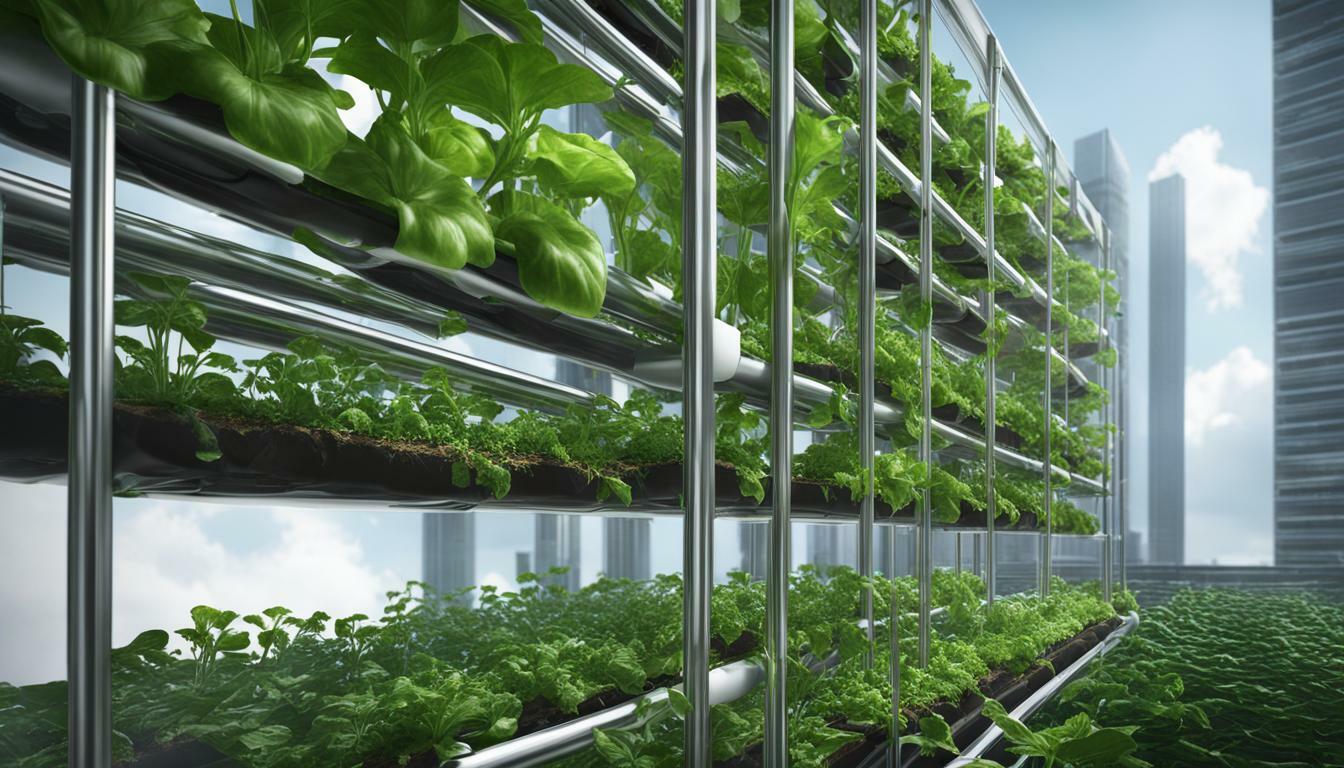Vertical hydroponic garden systems are revolutionizing urban farming in the USA, offering an efficient and innovative solution for growing more with less. These systems utilize vertical space to maximize growing capacity, making them ideal for small spaces and urban environments. By harnessing the power of hydroponics, these systems provide a controlled environment for plants to thrive, resulting in higher yields and healthier crops.
Vertical hydroponic garden systems have several key advantages. They save space by utilizing vertical structures, allowing gardeners to maximize their growing area. These systems are also highly efficient, using up to 90-95% less water compared to traditional soil-based gardening. Additionally, vertical hydroponic systems eliminate the need for soil, reducing the risk of pests and diseases and minimizing the use of chemical fertilizers and pesticides.
One notable vertical hydroponic system in the USA is the ZipGrow™ Farm Wall™. This versatile system is designed for both indoor and outdoor use and can be easily mounted on walls, fences, or buildings. The ZipGrow™ Farm Wall™ uses patented ZipGrow™ Towers to grow a variety of leafy greens, herbs, and fruiting crops. With options for different heights and widths, this system provides flexibility for growers with limited space.
Choosing the right vertical hydroponic system is crucial for success. Factors such as available space, budget, and desired plant varieties should be considered. It is also important to ensure that the system provides adequate lighting and nutrient delivery to support plant growth.
Vertical hydroponic gardens are known for their efficiency and productivity. With precise nutrient delivery and controlled environmental conditions, these systems enable plants to grow faster and produce higher yields compared to traditional growing methods. The ability to grow crops year-round further enhances productivity and ensures a steady supply of fresh produce.
Another major advantage of vertical hydroponics is the ability to maximize space. These systems allow growers to utilize vertical surfaces, such as walls and fences, to create additional growing areas. By stacking plants vertically, growers can significantly increase their growing capacity without taking up valuable floor space. This makes vertical hydroponics particularly suitable for urban areas where land is limited.
In addition to their practical benefits, vertical hydroponic gardens also offer environmental advantages. These systems use significantly less water compared to traditional soil-based gardening, making them a more sustainable option. Additionally, vertical hydroponics eliminate the need for chemical pesticides, reducing the environmental impact of crop production.
Vertical hydroponic gardens are not only effective in the present but also hold promise for the future. With the global population increasing and arable land becoming scarcer, vertical hydroponics offer a sustainable solution for food production. By maximizing space, conserving resources, and reducing carbon emissions, these systems have the potential to address future food production challenges.
Real-life success stories of vertical hydroponic gardens in the USA further highlight the effectiveness of these systems. Individuals and businesses have successfully grown a wide range of crops, including herbs, leafy greens, and fruiting plants, using vertical hydroponics. These success stories serve as inspiration and encourage more individuals to adopt this innovative method of gardening.
In conclusion, vertical hydroponic garden systems are transforming urban farming in the USA. With their space-saving design, efficient nutrient delivery, and environmental benefits, these systems offer a sustainable and productive solution for growing fresh produce. Whether it’s in homes, schools, or commercial settings, vertical hydroponic gardens are paving the way for a greener and more efficient future of agriculture.
Key Takeaways:
- Vertical hydroponic garden systems are revolutionizing urban farming in the USA, offering efficient and innovative solutions for maximizing growing capacity.
- These systems save space, use less water, and eliminate the need for soil, making them ideal for urban environments.
- The ZipGrow™ Farm Wall™ is a versatile vertical hydroponic system that allows for the cultivation of a variety of crops in limited space.
- Choosing the right vertical hydroponic system is crucial and depends on factors such as available space, budget, and desired plant varieties.
- Vertical hydroponic gardens are efficient, productive, and environmentally friendly, with the potential to address future food production challenges.
- Real-life success stories showcase the effectiveness and potential of vertical hydroponic gardens in the USA.
The Benefits of Vertical Hydroponic Garden Systems
Vertical hydroponic garden systems offer numerous benefits that make them a preferred choice for urban farming in the USA. These systems provide a space-efficient solution for growing a wide variety of crops, both indoors and outdoors. With vertical hydroponics, gardeners can maximize their growing capacity by utilizing vertical space, making it ideal for small indoor areas or limited outdoor spaces.
One of the key advantages of vertical hydroponic garden systems is their ability to save space. These systems allow for crops to be grown closer together, as the plants’ roots don’t need to spread out in search of nutrients. This means more crops can be grown in a smaller area, maximizing yield and productivity.
| Benefit | Description |
|---|---|
| Space Savings | Vertical hydroponic systems optimize limited space, making them suitable for urban gardening and small indoor or outdoor areas. |
| Lack of Soil | Hydroponics allows for soil-free growing, making it possible to grow crops in areas with limited arable land or unfavorable climates. |
| Efficiency & Productivity | Hydroponic systems deliver nutrients directly to the roots, resulting in faster and more efficient plant growth compared to traditional soil-based methods. |
| Low Maintenance | Vertical hydroponic systems require minimal maintenance and use up to 80% less water compared to traditional garden beds. |
Another significant advantage of vertical hydroponic garden systems is their efficiency and productivity. These systems provide optimal conditions for plant growth, allowing crops to grow faster and yield higher quantities of produce compared to traditional soil-based methods. Additionally, vertical hydroponics enables year-round crop production, making it possible to have a constant supply of fresh, locally grown produce regardless of the season.
Vertical hydroponic garden systems are also low maintenance. With closed-loop systems that recirculate water and nutrients, they require minimal water usage and reduce the need for chemical fertilizers, fungicides, and pesticides. This not only promotes environmental sustainability but also ensures that the harvested crops are safe and free from harmful residues.
Overall, the benefits of vertical hydroponic garden systems make them an attractive choice for urban farmers in the USA. These systems offer space savings, efficient and productive crop growth, low maintenance requirements, and environmentally friendly operation. Whether for home gardens, educational centers, or commercial applications, vertical hydroponic garden systems provide a sustainable solution for year-round, high-quality crop production.
Sources:- Foster plant growth with the ZipGrow™ Farm Wall™. Retrieved from [source link].
- VERTICAL HYDROPONIC FARM (VHF™). Retrieved from [source link].
- Advantages of Vertical Hydroponics. Retrieved from [source link].
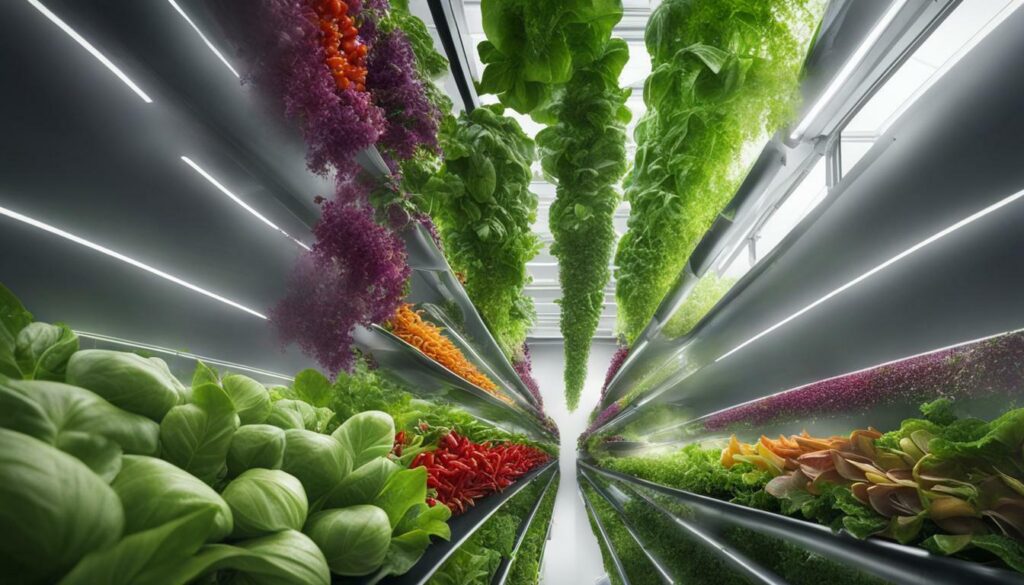
ZipGrow™ Farm Wall™: A Versatile Vertical Hydroponic System
The ZipGrow™ Farm Wall™ is a versatile vertical hydroponic system that provides a simple and productive solution for homes and commercial live sales. This innovative system allows for both indoor and outdoor use, harnessing the power of the sun or bright grow lights to maximize plant growth. With the ZipGrow™ Farm Wall™, growers can save 90-95% of water compared to traditional growing methods, making it an environmentally friendly choice.
What sets the ZipGrow™ Farm Wall™ apart is its ease of use and versatility. Designed with patented ZipGrow™ Towers, this hydroponic system can be easily mounted on walls, fences, or buildings, allowing for optimal space utilization. It is a perfect option for those with limited floor space, as it brings walls to life with a variety of leafy greens, herbs, and even fruiting crops.
The ZipGrow™ Farm Wall™ comes in various height and width options, catering to individual needs and space constraints. It is lightweight and can be mounted almost anywhere, making it suitable for both indoor and outdoor installations. For indoor use or areas with limited natural light, the Farm Wall™ Light Kit provides supplemental lighting, ensuring consistent year-round production.
| Farm Wall Options | Price Range |
|---|---|
| 8-Tower Farm Wall™ | USD 899.99 – USD 1,673.99 |
| 4-Tower Farm Wall™ | USD 629.99 – USD 1,016.99 |
| 2-Tower Farm Wall™ | USD 449.99 – USD 643.99 |
The benefits of the ZipGrow™ Farm Wall™ extend beyond its versatility and space-saving design. This system is designed for simplicity, making it accessible to those with little hydroponic growing experience. It offers proven crop yields and allows for efficient and productive growth, with plants growing up to 2 times faster than traditional soil production. This means a more abundant harvest and less time spent on maintenance.
The ZipGrow™ Farm Wall™ is a game-changer for urban gardening, providing a sustainable solution for growing fresh produce in limited spaces. Its versatility, efficiency, and productivity make it an excellent choice for both home growers and commercial operations.
With the ZipGrow™ Farm Wall™, learning hydroponics becomes accessible and affordable, making it a perfect tool for educational centers and individuals interested in exploring this innovative growing technique. It also offers the opportunity to save money on groceries by having a fresh supply of produce at hand, eliminating the need for wasteful store-bought produce that often goes to waste.
Whether you’re growing herbs, decorative plants, leafy greens, or fruiting crops, the ZipGrow™ Farm Wall™ provides an ideal environment for their growth. It allows for full control over temperature, light, and air composition, ensuring optimal conditions for maximizing crop growth rates, quality, and yield. With this system, fresh and nutrient-dense produce can be easily grown locally, reducing transportation emissions and promoting sustainability.
Overall, the ZipGrow™ Farm Wall™ offers a practical and sustainable solution for vertical hydroponic gardening. Its versatility, efficiency, and ability to maximize growing space make it an excellent choice for anyone looking to grow their own fresh produce in limited areas.
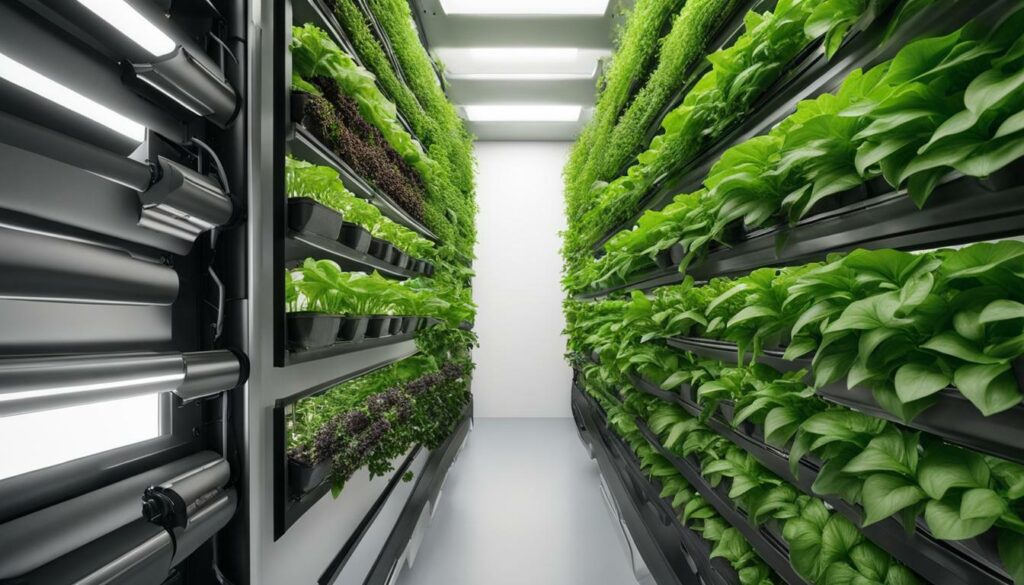
Choosing the Right Vertical Hydroponic System
Selecting the right vertical hydroponic system is essential to ensure optimal growth and yield in your urban farming endeavors. With the increasing popularity of vertical hydroponics, there are a variety of systems available on the market to suit different needs and preferences. Here are some key factors to consider when choosing the right vertical hydroponic system:
1. Space Requirements
Before selecting a vertical hydroponic system, assess the available space where you plan to set up your garden. Consider the height, width, and depth of the system, as well as the total number of plants you intend to grow. Some systems are more compact and suitable for small indoor spaces, while others are designed for larger outdoor areas. Be sure to choose a system that fits well within your space limitations.
2. Growing Capacity
Take into account the number of plants you want to grow and the potential yield of the system. Look for systems that offer the right number of planting slots or containers to meet your needs. Some systems may have modular designs, allowing you to expand or customize the growing capacity as your garden evolves.
3. System Features
Consider the features and functionality of the vertical hydroponic system. Look for systems that provide efficient water and nutrient circulation, as well as easy access to plants for maintenance and harvesting. Some systems may have built-in timers or automated controls for lighting and nutrient delivery, simplifying the growing process.
4. Lighting Options
If you plan to grow your vertical hydroponic garden indoors or in a space with limited natural light, consider the lighting options available with the system. Look for systems that offer energy-efficient LED grow lights or provide compatibility with supplemental lighting. Adequate lighting is crucial for the healthy growth of your plants.
5. Budget and Affordability
Set a budget for your vertical hydroponic system and explore options within your price range. Compare the costs of different systems, including the initial investment as well as ongoing maintenance and operation expenses. Consider the long-term benefits and potential return on investment when making your decision.
By carefully considering these factors, you can choose a vertical hydroponic system that aligns with your goals and resources. Whether you are a home grower or a commercial farmer, selecting the right system will contribute to the success and productivity of your vertical hydroponic garden.
| Factors to Consider | Important Points |
|---|---|
| Space Requirements | Assess available space and choose a system that fits well within your limitations. |
| Growing Capacity | Consider the number of plants you want to grow and ensure the system can accommodate your needs. |
| System Features | Look for efficient water and nutrient circulation, easy access for maintenance, and automated controls. |
| Lighting Options | If growing indoors, choose a system with energy-efficient LED lights or compatibility with supplemental lighting. |
| Budget and Affordability | Set a budget, compare costs, and consider long-term benefits and return on investment. |
Remember, finding the right vertical hydroponic system is crucial for the success of your urban farming venture. Take the time to research and compare options to ensure you make an informed decision that suits your space, goals, and budget.
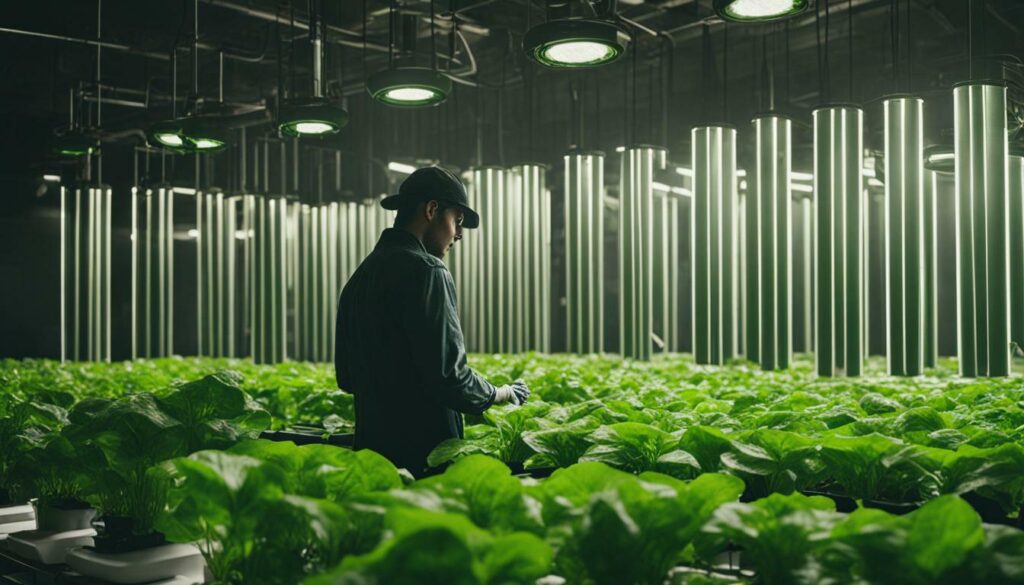
“Selecting the right vertical hydroponic system is essential to ensure optimal growth and yield in your urban farming endeavors.”
Implementing a vertical hydroponic system in your urban farming endeavors offers numerous benefits, including space-saving, efficient water usage, and increased productivity. By choosing the right system, you can create a thriving vertical garden that provides you with fresh and nutritious produce year-round.
The Efficiency and Productivity of Vertical Hydroponic Gardens
Vertical hydroponic gardens have proven to be highly efficient and productive, offering accelerated growth rates and increased crop yields. These innovative systems optimize space utilization, maximize resource efficiency, and provide a sustainable solution for year-round food production. By harnessing the power of controlled environments and nutrient-rich solutions, vertical hydroponics revolutionizes traditional farming methods.
One example of an effective vertical hydroponic system is the ZipGrow™ Farm Wall™. This versatile system utilizes patented ZipGrow™ Towers and can be easily mounted on walls, fences, or buildings. The Farm Wall™ allows for the cultivation of a wide variety of leafy greens, herbs, and fruiting crops, both indoors and outdoors. With the use of bright grow lights or natural sunlight, this system saves up to 95% of water compared to traditional growing methods.
Vertical hydroponic gardens offer several key advantages. They allow for maximum space utilization, making them ideal for urban environments where floor space is limited. By growing crops closer together and providing precise nutrient delivery directly to the roots, these systems achieve optimal growth rates and increased productivity. Additionally, vertical hydroponics reduce the need for pesticides and chemical fertilizers, resulting in clean and safe produce.
A study conducted by FarmBox Foods found that vertical hydroponics can conserve up to 80% of water compared to traditional soil-based farming. This level of water efficiency, combined with controlled environmental factors such as temperature, light, and air composition, maximizes crop growth and minimizes resource waste. Furthermore, vertical hydroponic systems can be easily monitored and controlled through remote monitoring software, allowing for efficient management and maintenance.
Table: Crop Options for Vertical Hydroponic Gardens
| Category | Crops |
|---|---|
| Herbs | Basil, Cilantro, Rosemary, Dill, Oregano, Thyme, Mint, Parsley, Chives |
| Decorative | Marigolds, Jade Tree, Aloe, Dianthus, Nasturtiums, Asters, Poppies, Snapdragons |
| Leafy Greens | Lettuce, Spring Mix, Watercress, Tatsoi, Bok Choy, Arugula, Kale |
| Fruiting | Hot Peppers, Sweet Peppers, Tomatoes, Strawberries, Eggplants, Chili Peppers, Jalapeños, Alpine Berries |
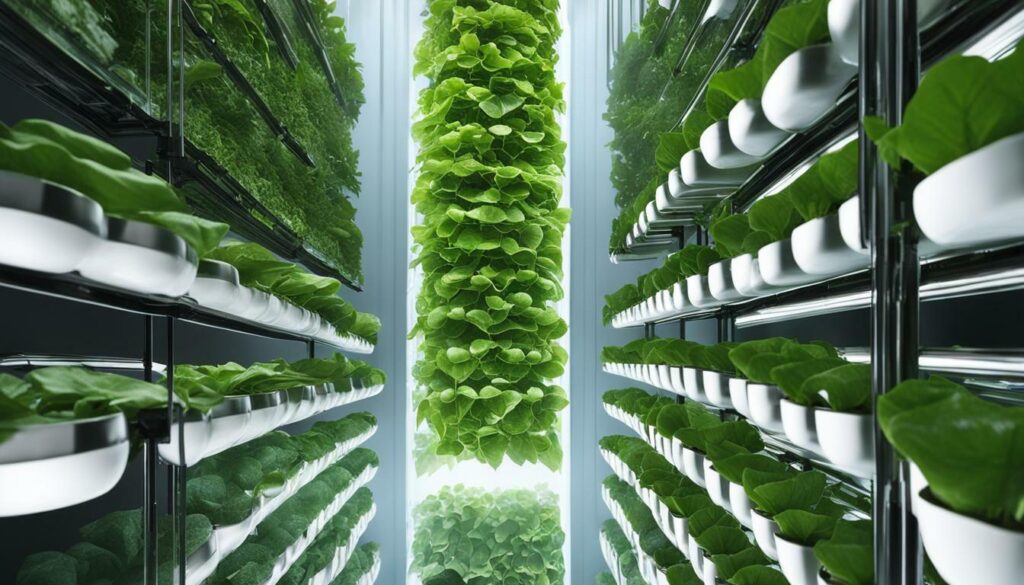
“Fresh greens and herbs growing on my kitchen wall, so amazing. It tastes like something completely different than what I have been buying all these years from the grocery store.” – Jason Dvorak, Ontario, Canada
Vertical hydroponic gardens not only provide an efficient and sustainable solution for crop production but also offer numerous benefits in terms of space savings, resource conservation, and improved food safety. By adopting these innovative systems, individuals and communities can take control of their food production, reduce their carbon footprint, and enjoy fresh and nutrient-rich produce year-round.
Maximizing Space with Vertical Hydroponics
One of the biggest advantages of vertical hydroponics is its ability to maximize growing space, making it ideal for urban farming in the USA. By utilizing vertical space, vertical hydroponic systems allow for the cultivation of a wide variety of plants in areas where floor space may be limited.
The ZipGrow™ Farm Wall™ is a versatile vertical hydroponic system that offers efficient use of space. With its patented ZipGrow™ Towers, this system can be easily hung on walls, fences, or buildings, bringing walls to life and transforming any small vertical surface into a productive growing space. Whether it’s an outdoor patio wall or an indoor spare room, the ZipGrow™ Farm Wall™ provides a compact solution for growing a healthy variety of leafy greens, herbs, and fruiting crops.
The Farm Wall™ comes in various height and width options, allowing for customization based on individual needs and available space. Its slim design ensures minimal space requirements, making it suitable for even the smallest of areas. Furthermore, if natural light is limited, the Farm Wall™ Light Kit provides supplemental lighting for indoor use, ensuring consistent and year-round production.
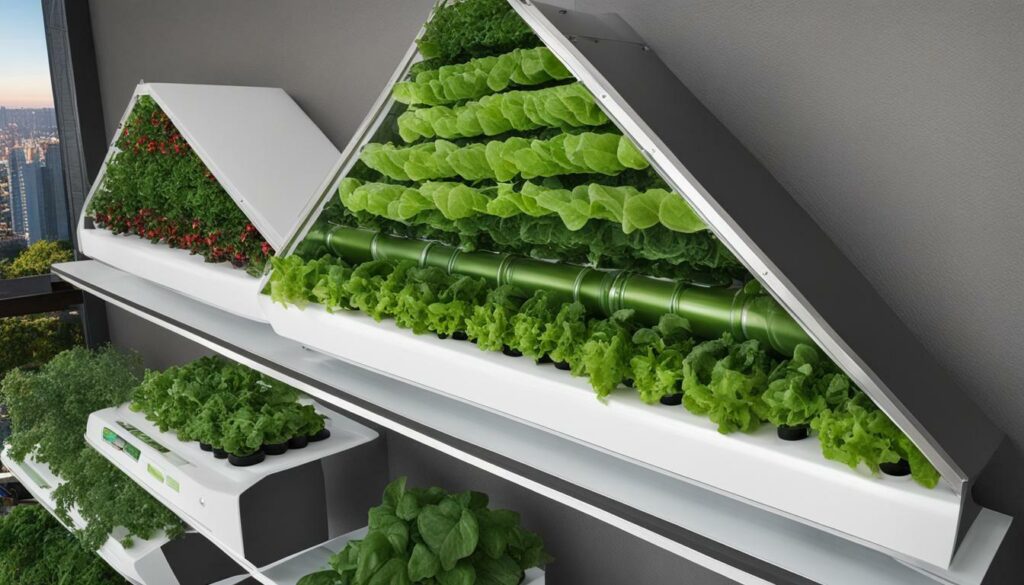
In addition to maximizing space, vertical hydroponic systems offer other benefits such as efficient water usage and reduced reliance on pesticides. As the plants’ roots are suspended directly in nutrient-rich solution, they require less space to search for nutrients compared to soil-based cultivation. This allows for closer planting and greater crop density.
Vertical hydroponics also provides better control over temperature, light, air composition, and pests, resulting in faster growth rates, higher crop yields, and year-round production. The efficient use of resources, such as water conservation, is another advantage of vertical hydroponics, making it an environmentally friendly option for sustainable food production.
Overall, vertical hydroponics is a space-saving and efficient solution for maximizing growing capacity in limited areas. It offers the potential for urban farming in the USA to thrive, providing fresh and nutritious produce locally while minimizing environmental impact. Whether it’s in homes, schools, or commercial settings, vertical hydroponic systems like the ZipGrow™ Farm Wall™ are revolutionizing the way we grow food, ensuring a sustainable and productive future of agriculture.
The Environmental Benefits of Vertical Hydroponic Gardens
Vertical hydroponic gardens offer significant environmental benefits, including water conservation and pesticide-free growing practices. These innovative systems use a fraction of the water required by traditional soil-based farming methods, making them a sustainable solution for a water-scarce world. Additionally, vertical hydroponics eliminate the need for harmful pesticides, promoting healthier and safer food production. Let’s explore the environmental advantages of vertical hydroponic gardens in more detail.
“Vertical hydroponic systems save 90-95% of the water compared to traditional growing methods.”
One of the biggest environmental benefits of vertical hydroponic gardens is their water efficiency. Traditional soil-based farming methods require large amounts of water to nourish plants and maintain soil moisture. In contrast, vertical hydroponics use a recirculating system that delivers water directly to the plant roots, eliminating water waste. Studies have shown that vertical hydroponic systems save 90-95% of the water compared to traditional growing methods. This significant reduction in water usage helps conserve precious freshwater resources and mitigates the environmental impact of agriculture.
Furthermore, vertical hydroponic gardens eliminate the need for pesticides and herbicides. By growing plants in a controlled indoor environment, hydroponic systems are less susceptible to pests and diseases. This reduces the reliance on chemical pesticides, protecting the environment from harmful substances and minimizing the risk of pesticide residues in the harvested crops. With vertical hydroponics, growers can cultivate healthy and pesticide-free produce, promoting food safety and sustainability.
| Environmental Benefits of Vertical Hydroponic Gardens: |
|---|
| Water conservation |
| Pesticide-free growing |
The Future of Sustainable Agriculture
The environmental advantages of vertical hydroponic gardens make them a promising solution for sustainable agriculture in the future. With the world facing challenges such as water scarcity, soil erosion, and climate change, vertical hydroponics offer a way to produce food efficiently and responsibly. These systems can be implemented in urban areas where space is limited, allowing for local food production and reducing the carbon footprint associated with long-distance transportation of produce.
Moreover, vertical hydroponic gardens provide opportunities for vertical farming, where crops are grown in multiple stacked layers, maximizing space utilization. This vertical farming concept enables high-density food production in urban environments, reducing the need for large areas of land and preserving natural habitats. By embracing vertical hydroponics, we can create a more sustainable and resilient food system that meets the growing demand for fresh, healthy, and locally grown produce.
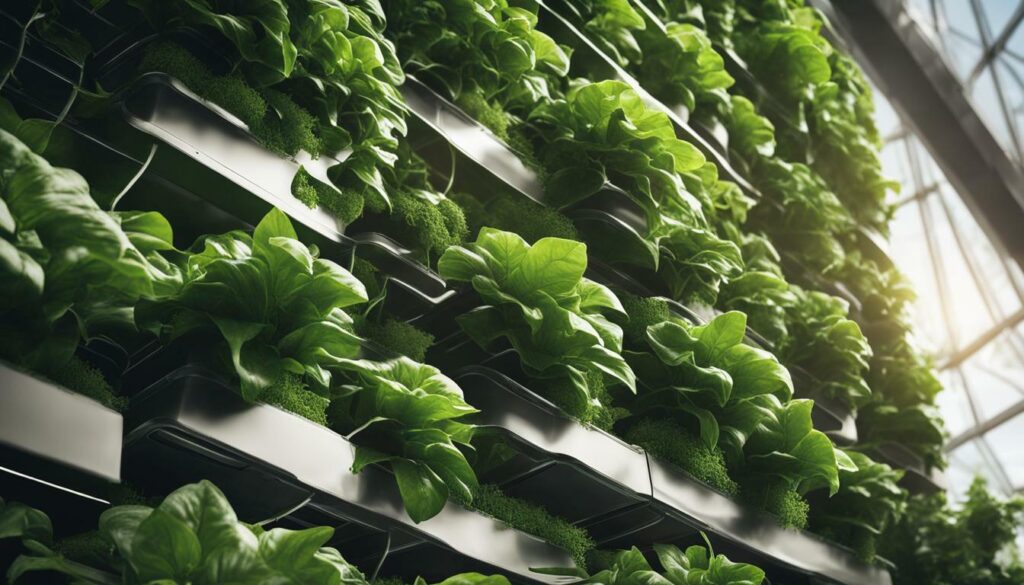
In conclusion, vertical hydroponic gardens offer significant environmental benefits by conserving water, eliminating the use of pesticides, and promoting sustainable agriculture. These innovative systems provide a way to grow food efficiently and responsibly, addressing the challenges of water scarcity and climate change. By embracing vertical hydroponics, we can work towards a more sustainable future for food production.
Vertical Hydroponic Gardens: A Sustainable Solution for the Future
As the demand for sustainable food production increases, vertical hydroponic gardens emerge as a promising solution for the future of farming. These innovative systems offer numerous advantages over traditional farming methods, making them an attractive option for both home growers and commercial operations.
One of the key advantages of vertical hydroponic gardens is their space-saving design. With limited floor space in urban areas, vertical systems provide a way to maximize growing capacity. By utilizing vertical space, these gardens can be set up in small indoor or outdoor areas, making them ideal for urban gardening and bringing fresh produce closer to where people live.
Vertical hydroponic gardens also offer environmental benefits. By using a soil-free system, they eliminate the need for large land areas and reduce water consumption. In fact, hydroponic systems can conserve up to 80% of water compared to traditional soil-based farming methods. Additionally, the controlled environment of vertical hydroponics reduces the need for pesticides, promoting safer and healthier food production.
| Advantages of Vertical Hydroponic Gardens | |
|---|---|
| Space Savings | Vertical systems optimize limited space, making them suitable for urban areas and small indoor or outdoor spaces. Plants can be grown closer together, maximizing yield. |
| Lack of Soil | Vertical hydroponic gardens eliminate the need for soil, making them ideal for arid climates, areas with soil erosion, or places with limited arable land. |
| Efficiency & Productivity | Plants in hydroponic systems receive optimal nutrition directly at the roots, leading to faster growth, higher yield, and year-round production. |
| Low Maintenance | Hydroponic systems require less water and have fewer maintenance demands compared to traditional gardening methods. |
Not only do vertical hydroponic gardens offer these benefits, but they also provide an opportunity for individuals to grow their own food and become more self-sufficient. Whether it’s a small home garden or a larger commercial operation, vertical hydroponics offer a sustainable solution for the future of farming.
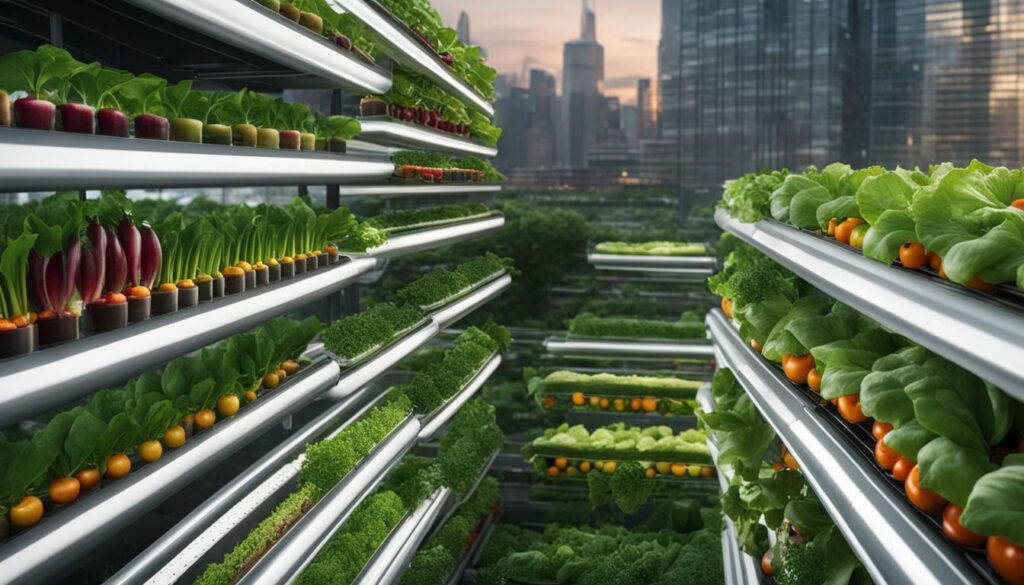
Success Stories: Vertical Hydroponic Gardens in the USA
From urban homes to commercial farms, vertical hydroponic gardens have transformed the way people grow their own fresh produce in the USA. These innovative systems have enabled individuals and businesses to overcome space limitations, achieve high yields, and contribute to sustainable food production. Here are a few success stories showcasing the effectiveness of vertical hydroponic gardens in the USA.
Urban Oasis Farm: Growing Fresh Greens in the Heart of New York City
Urban Oasis Farm, located in New York City, is a prime example of how vertical hydroponic gardens are bringing fresh produce to urban areas. With limited space available, Urban Oasis Farm utilizes vertical towers to grow a wide variety of leafy greens and herbs. The farm delivers fresh and pesticide-free produce directly to local restaurants, farmers’ markets, and consumers, reducing food miles and ensuring maximum freshness. By implementing sustainable farming practices, Urban Oasis Farm demonstrates the potential of vertical hydroponic gardens to provide locally grown food in densely populated cities.
FarmBox Foods: Decentralizing Agriculture and Reducing Carbon Emissions
FarmBox Foods is revolutionizing agriculture with its portable and transportable hydroponic vertical farms. These farms maximize growing space while minimizing energy and water usage. By using vertical farming technology and combining it with solar capabilities, FarmBox Foods is reshaping the future of food production. These self-contained farms can be deployed in various locations, reducing the need for long-distance transport and reducing the carbon emissions associated with conventional farming. FarmBox Foods is paving the way for sustainable and decentralized agriculture, making locally grown, nutrient-dense produce more accessible.
Community-Supported Agriculture: Empowering Local Communities
Community-supported agriculture (CSA) programs across the USA have embraced vertical hydroponic gardens to enhance the supply of fresh and sustainable produce to their members. These programs connect local farmers with consumers, creating a direct and mutually beneficial relationship. Vertical hydroponic gardens allow CSA farmers to grow a wide range of crops in a compact space, ensuring a diverse and consistent supply of fresh produce year-round. By supporting local farmers and participating in CSA programs, individuals can enjoy the benefits of locally grown food while fostering community engagement and reducing their ecological footprint.
| Success Stories | Location | Key Features |
|---|---|---|
| Urban Oasis Farm | New York City | – Vertical towers for growing fresh greens – Delivery to local restaurants and markets – Sustainable farming practices |
| FarmBox Foods | Various locations | – Portable and transportable vertical farms – Maximized growing space – Solar capabilities – Decentralized agriculture |
| Community-Supported Agriculture | USA-wide | – Compact vertical hydroponic gardens – Diverse crop selection – Consistent supply of fresh produce – Local farmer-consumer connection |
These success stories illustrate the wide-ranging benefits and potential of vertical hydroponic gardens in the USA. From urban farms in bustling cities to community-supported agriculture programs, these systems are revolutionizing how fresh produce is grown, harvested, and delivered. By implementing vertical hydroponic gardens, individuals and businesses are not only providing access to locally grown food but also contributing to a more sustainable and resilient food system for the future.
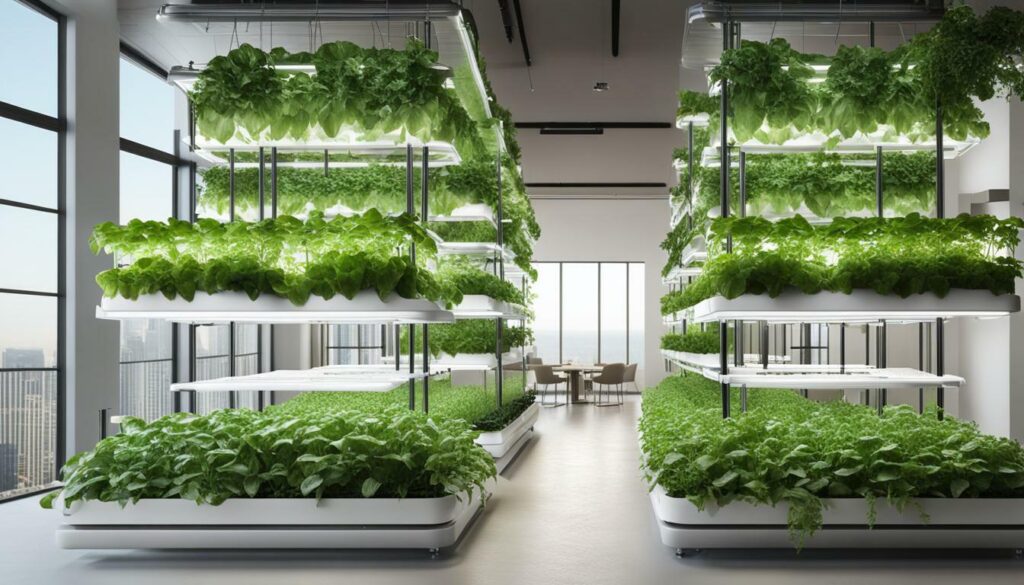
Conclusion
Vertical hydroponic garden systems are revolutionizing urban farming in the USA, offering an efficient and sustainable solution for growing fresh produce year-round. These innovative systems provide numerous benefits, making them a popular choice for home growers, educational centers, and commercial operations.
One notable vertical hydroponic system is the ZipGrow™ Farm Wall™, which combines versatility and ease of use. This system can be used indoors or outdoors, harnessing the power of the sun or grow lights while saving up to 95% of water compared to traditional growing methods. The Farm Wall™ is perfect for growing a variety of leafy greens, herbs, and fruiting crops, and it comes in different height and width options to suit individual space limitations.
Choosing the right vertical hydroponic system is crucial, as it should cater to your specific needs and available space. Consider factors such as system size, lighting requirements, and ease of maintenance when making your selection.
Vertical hydroponic gardens are highly efficient and productive, offering faster growth rates and higher crop yields compared to traditional soil-based methods. These systems allow for space-saving and maximize growing capacity, making them ideal for urban environments where space is limited. Additionally, vertical hydroponics has significant environmental benefits, including reduced water usage and the elimination of chemical pesticides.
Vertical hydroponic gardens present a sustainable solution for the future of food production. With their ability to grow fresh produce locally and year-round, they have the potential to address food security challenges and reduce the carbon footprint associated with traditional farming practices.
Real-life success stories of individuals and businesses using vertical hydroponic gardens in the USA further highlight the effectiveness and potential of these systems. From growing fresh greens and herbs in a kitchen to supplying restaurants and farmers’ markets, vertical hydroponics is transforming the way we grow and consume food.
In conclusion, vertical hydroponic garden systems offer a promising alternative to traditional farming methods in the USA. Their numerous benefits, including space efficiency, environmental friendliness, and high productivity, make them an attractive option for both home growers and commercial operations. As we look towards a more sustainable future, vertical hydroponics plays a crucial role in ensuring a consistent supply of fresh, nutritious produce.
Are Aquaponic Vertical Garden Systems as Effective as Traditional Vertical Hydroponic Garden Systems in the USA?
Aquaponic vertical garden techniques offer a more sustainable approach to gardening in the USA. While traditional vertical hydroponic systems rely solely on nutrient solutions, aquaponic systems utilize fish waste to fertilize plants. This symbiotic relationship creates a more efficient and natural way to grow crops in a vertical setting.
FAQ
Q: What are the benefits of using vertical hydroponic garden systems?
A: Vertical hydroponic garden systems provide space savings, efficient use of resources, high productivity, low maintenance, and the ability to grow crops year-round.
Q: What makes the ZipGrow™ Farm Wall™ a versatile vertical hydroponic system?
A: The ZipGrow™ Farm Wall™ is a versatile vertical hydroponic system that can be used both indoors and outdoors. It is easy to use, saves water compared to traditional growing methods, and can be mounted on any vertical surface.
Q: How do vertical hydroponic gardens maximize space?
A: Vertical hydroponic gardens allow for space-saving by utilizing vertical space instead of traditional horizontal garden beds. This maximizes growing capacity in limited areas.
Q: What are the environmental benefits of vertical hydroponic gardens?
A: Vertical hydroponic gardens reduce water usage, minimize the need for pesticides, and can be more sustainable compared to traditional soil-based farming methods. They also have the potential to reduce greenhouse gas emissions and damage to local ecosystems.
Q: How can vertical hydroponic gardens address future food production challenges?
A: Vertical hydroponic gardens offer a sustainable solution for the future by maximizing productivity in limited spaces, conserving water resources, reducing reliance on pesticides, and providing year-round crop production.
Q: Are there any success stories of vertical hydroponic gardens in the USA?
A: Yes, there are numerous success stories of individuals and businesses using vertical hydroponic gardens in the USA. These gardens have provided fresh and nutritious produce, improved food security, and created opportunities for local food production.
Q: What are the key considerations when choosing a vertical hydroponic system?
A: When choosing a vertical hydroponic system, factors to consider include available space, desired crop types, installation requirements, maintenance needs, and budget. It’s important to select a system that fits your specific needs and goals.
Q: How do vertical hydroponic gardens compare to traditional growing methods in terms of efficiency and productivity?
A: Vertical hydroponic gardens are highly efficient and productive due to precise nutrient delivery, optimized growing conditions, and the ability to grow crops closer together. They can achieve higher yields and faster growth rates compared to traditional soil-based farming methods.
Q: What are the advantages of utilizing vertical hydroponic gardens in the USA?
A: Vertical hydroponic gardens in the USA offer benefits such as space savings, reduced water usage, year-round crop production, controlled growing conditions, and the potential to address sustainability and food production challenges.
Q: How do vertical hydroponic gardens minimize maintenance requirements?
A: Vertical hydroponic gardens are designed for low maintenance, as they involve recirculating water and nutrients in a closed-loop system. This minimizes water wastage, reduces the need for frequent watering, and eliminates the need for weeding and soil-based pests.
Q: Why are vertical hydroponic gardens considered a sustainable solution for the future?
A: Vertical hydroponic gardens are considered a sustainable solution for the future because they maximize productivity in limited spaces, conserve water resources, minimize pesticide usage, and reduce the carbon footprint associated with food transportation and traditional farming methods.

